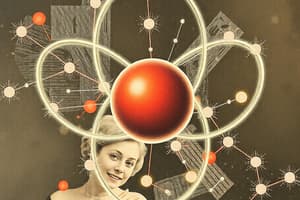Podcast
Questions and Answers
What type of reaction involves the transfer of thermal energy from the surroundings to the chemicals?
What type of reaction involves the transfer of thermal energy from the surroundings to the chemicals?
- Catalytic reaction
- Redox reaction
- Exothermic reaction
- Endothermic reaction (correct)
What happens to the temperature of the environment during an endothermic reaction?
What happens to the temperature of the environment during an endothermic reaction?
- The temperature decreases (correct)
- The temperature fluctuates dramatically
- The temperature remains constant
- The temperature increases
What is required for chemical reactions to take place between particles?
What is required for chemical reactions to take place between particles?
- Collision with sufficient energy (correct)
- High pressure
- Stable temperature
- Chemical catalysts
What is defined as the minimum energy required for particles to react?
What is defined as the minimum energy required for particles to react?
In a reaction profile, which of the following typically indicates the energy changes during a reaction?
In a reaction profile, which of the following typically indicates the energy changes during a reaction?
What type of material is acknowledged for reproduction in this publication?
What type of material is acknowledged for reproduction in this publication?
Which type of organization is AQA identified as in the content?
Which type of organization is AQA identified as in the content?
What is the main purpose of the acknowledgments section in this publication?
What is the main purpose of the acknowledgments section in this publication?
Which type of visual content is frequently mentioned in the acknowledgments?
Which type of visual content is frequently mentioned in the acknowledgments?
What type of permission is primarily discussed in this content?
What type of permission is primarily discussed in this content?
In what context is AQA's material credited?
In what context is AQA's material credited?
Which aspect of the publication could be considered a form of academic integrity?
Which aspect of the publication could be considered a form of academic integrity?
What would likely be an important reason for including such acknowledgments?
What would likely be an important reason for including such acknowledgments?
Which particle in an atom carries a positive charge?
Which particle in an atom carries a positive charge?
Where do electrons reside in an atom?
Where do electrons reside in an atom?
What is the approximate radius of a nucleus compared to the entire atom?
What is the approximate radius of a nucleus compared to the entire atom?
Which of the following statements about neutrons is true?
Which of the following statements about neutrons is true?
What does the mass of an atom primarily consist of?
What does the mass of an atom primarily consist of?
What is the radius of a hydrogen atom in standard form?
What is the radius of a hydrogen atom in standard form?
How is the size of the nucleus often compared visually?
How is the size of the nucleus often compared visually?
Which particle is associated with a negative charge?
Which particle is associated with a negative charge?
Which arrow indicates the activation energy for the reaction?
Which arrow indicates the activation energy for the reaction?
In a reaction diagram, what do the reactants represent?
In a reaction diagram, what do the reactants represent?
Which part of the reaction diagram illustrates the difference in energy between reactants and products?
Which part of the reaction diagram illustrates the difference in energy between reactants and products?
What happens to the energy of reactants during an exothermic reaction?
What happens to the energy of reactants during an exothermic reaction?
What can be inferred if the products are at a lower energy level than the reactants in a reaction diagram?
What can be inferred if the products are at a lower energy level than the reactants in a reaction diagram?
Which arrow would depict the energy required to reach the transition state?
Which arrow would depict the energy required to reach the transition state?
In a reaction diagram, what does the area above the reactants and below the transition state represent?
In a reaction diagram, what does the area above the reactants and below the transition state represent?
What does a plateau in the reaction energy diagram typically indicate?
What does a plateau in the reaction energy diagram typically indicate?
What is a unique characteristic of graphite in its solid state?
What is a unique characteristic of graphite in its solid state?
What range must electrical conductivity be within for materials like graphite?
What range must electrical conductivity be within for materials like graphite?
Which property distinguishes calcium from graphite in terms of conductivity?
Which property distinguishes calcium from graphite in terms of conductivity?
What happens to graphite's conductivity when it is molten?
What happens to graphite's conductivity when it is molten?
Which of the following best describes the bonding properties of graphite?
Which of the following best describes the bonding properties of graphite?
Which statement about the structure of graphite is incorrect?
Which statement about the structure of graphite is incorrect?
What distinguishes the conductivity of molten calcium from that of graphite?
What distinguishes the conductivity of molten calcium from that of graphite?
What aspect of the structure of graphite contributes to its unique conductive properties?
What aspect of the structure of graphite contributes to its unique conductive properties?
When comparing the electrical conductive properties of metals and graphite, which statement is true?
When comparing the electrical conductive properties of metals and graphite, which statement is true?
Which of the following statements about the conductivity of graphite is correct?
Which of the following statements about the conductivity of graphite is correct?
How should the number 0345 be expressed in scientific notation?
How should the number 0345 be expressed in scientific notation?
What is the correct representation of 0345 when converted to scientific notation?
What is the correct representation of 0345 when converted to scientific notation?
When converting a number to scientific notation, what is the criterion for the digit placement?
When converting a number to scientific notation, what is the criterion for the digit placement?
In which scenario would you write 0.345 in scientific notation?
In which scenario would you write 0.345 in scientific notation?
What does the notation × 10 represent when writing numbers in scientific notation?
What does the notation × 10 represent when writing numbers in scientific notation?
Which is a common mistake when writing numbers in scientific notation?
Which is a common mistake when writing numbers in scientific notation?
What is the importance of moving the decimal point when writing scientific notation?
What is the importance of moving the decimal point when writing scientific notation?
Why is it essential to write numbers in scientific notation, particularly when they are larger or smaller than 1?
Why is it essential to write numbers in scientific notation, particularly when they are larger or smaller than 1?
If you were to express the number 3450 in scientific notation, which of the following would be correct?
If you were to express the number 3450 in scientific notation, which of the following would be correct?
Flashcards
AQA GCSE Chemistry
AQA GCSE Chemistry
A specific chemistry curriculum for GCSE level students offered by the AQA examination board.
Student Book
Student Book
A textbook specifically designed for teaching and learning the AQA GCSE Chemistry curriculum.
Richard Grime
Richard Grime
Possible author or contributor of the AQA GCSE Chemistry Student Book.
Nora Henry
Nora Henry
Signup and view all the flashcards
Copyright Material
Copyright Material
Signup and view all the flashcards
Photographic Credits
Photographic Credits
Signup and view all the flashcards
Reproductions of Copyright Material
Reproductions of Copyright Material
Signup and view all the flashcards
Content Permissions
Content Permissions
Signup and view all the flashcards
Endothermic reaction
Endothermic reaction
Signup and view all the flashcards
Collision
Collision
Signup and view all the flashcards
Activation energy
Activation energy
Signup and view all the flashcards
Reaction Profile
Reaction Profile
Signup and view all the flashcards
Temperature
Temperature
Signup and view all the flashcards
Proton
Proton
Signup and view all the flashcards
Neutron
Neutron
Signup and view all the flashcards
Electron
Electron
Signup and view all the flashcards
Nucleus
Nucleus
Signup and view all the flashcards
Energy Level (Shell)
Energy Level (Shell)
Signup and view all the flashcards
What is the relative size of the nucleus compared to the atom?
What is the relative size of the nucleus compared to the atom?
Signup and view all the flashcards
Where is most of the atom's mass located?
Where is most of the atom's mass located?
Signup and view all the flashcards
How do electrons move around the nucleus?
How do electrons move around the nucleus?
Signup and view all the flashcards
Progress of Reaction
Progress of Reaction
Signup and view all the flashcards
Reactants
Reactants
Signup and view all the flashcards
Products
Products
Signup and view all the flashcards
What is the activation energy in a reaction profile?
What is the activation energy in a reaction profile?
Signup and view all the flashcards
What does the activation energy tell us about the rate of reaction?
What does the activation energy tell us about the rate of reaction?
Signup and view all the flashcards
Graphite Structure
Graphite Structure
Signup and view all the flashcards
Graphite Bonding
Graphite Bonding
Signup and view all the flashcards
Graphite Conductivity
Graphite Conductivity
Signup and view all the flashcards
Graphite Uses
Graphite Uses
Signup and view all the flashcards
Comparing Calcium and Graphite
Comparing Calcium and Graphite
Signup and view all the flashcards
Delocalized Electrons
Delocalized Electrons
Signup and view all the flashcards
Covalent Bonds
Covalent Bonds
Signup and view all the flashcards
Electrical Conductivity in Solids
Electrical Conductivity in Solids
Signup and view all the flashcards
Standard Form
Standard Form
Signup and view all the flashcards
How is Graphite Used in Pencils?
How is Graphite Used in Pencils?
Signup and view all the flashcards
Scientific Notation
Scientific Notation
Signup and view all the flashcards
Decimal Point
Decimal Point
Signup and view all the flashcards
Significant Digits
Significant Digits
Signup and view all the flashcards
Power of Ten
Power of Ten
Signup and view all the flashcards
Exponent
Exponent
Signup and view all the flashcards
Base Number
Base Number
Signup and view all the flashcards
Moving the Decimal Point
Moving the Decimal Point
Signup and view all the flashcards
Expressing in Scientific Notation
Expressing in Scientific Notation
Signup and view all the flashcards
Non-Zero Digits
Non-Zero Digits
Signup and view all the flashcards
Place After Decimal
Place After Decimal
Signup and view all the flashcards
Study Notes
Atomic Structure
- Atoms have a nucleus containing protons and neutrons.
- Electrons orbit the nucleus in energy levels (shells).
- The nucleus is significantly smaller than the overall atom.
- Most of an atom's mass is concentrated in the nucleus.
- Proton: positively charged particle in the nucleus
- Neutron: neutral particle in the nucleus
- Electron: negatively charged particle orbiting the nucleus
- Energy levels (shells): regions where electrons are located
- 1 nm = 1 × 10⁻⁹ m
Calculations
- Convert 0.070 nm to metres: 7.0 × 10⁻¹¹ m
- Convert 2.5 × 10⁻¹¹ m to nanometres: 0.025 nm
Key Terms
- Nucleus: central part of an atom; contains protons and neutrons
- Proton: positively charged particle in the nucleus
- Neutron: neutral particle in the nucleus
- Electron: negatively charged particle
- Energy level (shell): region of space around the nucleus where electrons are found
Studying That Suits You
Use AI to generate personalized quizzes and flashcards to suit your learning preferences.




